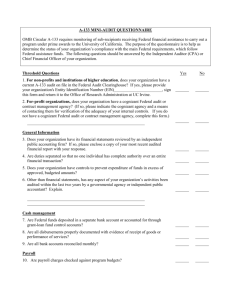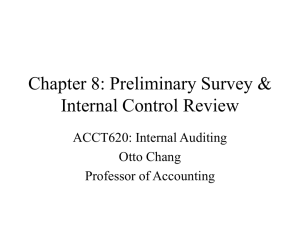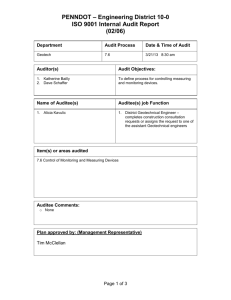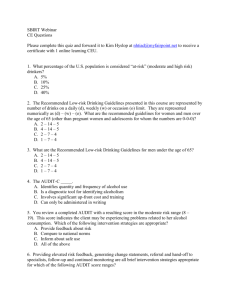Understanding Major Program Determination
advertisement
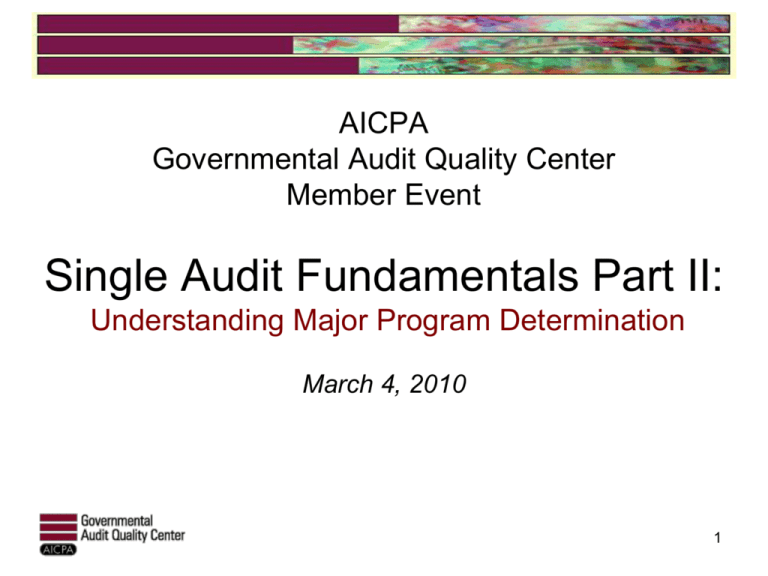
AICPA Governmental Audit Quality Center Member Event Single Audit Fundamentals Part II: Understanding Major Program Determination March 4, 2010 1 Administrative Notes • If you encounter any technical difficulties (e.g., audio issues) during this event please take the following steps: – – – – – – – Press the F5 key on your computer Re-start your browser Check your speakers, ensure they are not on mute Turn off your pop-up blocker Re-start you computer Call Genesys Tech support 866.814.1918 If none of the above work, submit a request for help on the “Send a Question Box” located on the left hand side of your screen. • If are unable to get assistance from Genesys for some reason, e-mail gaqc@aicpa.org or call 202-434-9207 2 Administrative Notes • We encourage you to submit your technical questions – please limit your questions to the content of today’s program • To submit a question, type it into the “Send a Question” box on left side of your screen; we will answer as many as possible • You can also submit questions to the GAQC member forum for consideration by other members • This event is being recorded and will be posted in an archive format to the GAQC Web site 3 Continuing Professional Education • Must have registered for CPE credit prior to this event; the CPE Credit Approval Form was e-mailed to you • Listen for announcement of 4 CPE codes (7 digit codes: ALL_ _ _ _ ) and 4 polling questions during the event • Record CPE Codes on CPE Credit Approval Form and return completed form (by fax or mail) to AICPA Service Center for record of attendance; keep a copy for your records • If you are not receiving CPE for this call, ignore the CPE codes that we announce, but please answer the polling questions 4 Single Audit Fundamentals Series Sponsored by the GAQC • What is GAQC? – Voluntary membership Center for CPA firms and State Audit Organizations (SAOs), with approximately 1,400 members – Designed to help CPAs meet the challenges of performing quality governmental audits, including single audits – Member benefits/membership requirements – For more information, please visit the membership section at www.aicpa.org/GAQC or call Cynthia Dillon at 202-434-9207 5 A Note on the Recovery Act • In February 2009, the American Recovery and Reinvestment Act of 2009 (ARRA) was passed • • • • • Approximately $300 billion additional federal funds being passed down; much of which is subject to single audits Recovery Act does have implications on major program determination Today’s call is focusing on basic major program determination considerations A future GAQC event (not yet scheduled) will provide additional information on the Recovery Act, including effects on major program determination Review the GAQC Recovery Act Resource Center (www.aicpa.org/GAQC) for previous calls and guidance issued 6 Today’s Presenters Flo Ostrum, CPA Grant Thornton LLP ___ Jennifer Shields, CPA Heinfeld, Meech Co., PC ___ Moderator Corey Arvizu, CPA Heinfeld, Meech Co., PC Chair, GAQC Executive Committee 7 Single Audit Fundamentals 8 Single Audit Fundamentals Events • Part I – Basic Background & Overview of the Single Audit – Scope of the Single Audit – Auditee & Auditor Responsibilities – Unique Requirements & Provisions of OMB Circular A-133 – Description & Characteristics of Federal Awards – Pass-through Awards and Subrecipients • Part II – Understanding Major Program Determination – Applying the Risk-Based Approach for Determining Major Programs – Low-Risk Auditee Determination and Distinguishing from Other Risk Assessments Performed in a Single Audit – Communications with Cognizant or Oversight Agency 9 Single Audit Fundamentals Events • Part III - Understanding Compliance Testing & IC over Compliance Requirements (March 11, 2010, from 1:00pm – 3:00pm Eastern) – – – – – – Description & Characteristics of the 14 Compliance Requirements Description & Characteristics of Internal Control over Compliance Substantive Tests of Applicable Compliance Requirements Tests of Internal Control over Compliance Documentation Requirements Introduction to and Using the Annual OMB Compliance Supplement 10 Single Audit Fundamentals Events • Part IV - Reporting Requirements and an Overview of Available Circular A-133 Resources (March 18, 2010, from 1:00pm – 3:00pm Eastern) – Reporting Requirements of the Single Audit – Overview and Use of the AICPA Audit Guide, Government Auditing Standards and Circular A-133 Audits (GAS/A-133 Guide) and Audit Risk Alert – Understanding the OMB Cost Circulars and their Applicability to Audit Procedures – Use of www.cfda.gov and other Web Sites to Facilitate a Single Audit 11 Considerations PRIOR to Major Program Determination 12 Considerations PRIOR to Major Program Determination • Planning begins with – Satisfying OMB A-133 requirements – Establishing an understanding with the auditee – Additional requirements of the Single Audit Act • documentation (access) • follow-up on prior year findings – Financial statement audit considerations 13 Considerations PRIOR to Major Program Determination • Planning also involves • Defining the entity to be audited • Determining the audit period • Timing of audit completion • Obtaining schedule of expenditures of federal awards 14 Considerations PRIOR to Major Program Determination • Guidance – OMB Circular A-133 http://www.whitehouse.gov/omb/circulars_a133/ – OMB Circular A-133 Compliance Supplement http://www.whitehouse.gov/omb/financial_offm_circulars/ • Issued annually – use the CURRENT year’s supplement • Pay attention to the issuance of any addenda – GAS/A-133 Guide 15 TOPICS to be COVERED • Applying the Risk-Based Approach for Determining Major Programs (MP) • Low-Risk Auditee Determination • Communications with Cognizant or Oversight Agency 16 Major Program Determination & Risk Assessment • Risk based approach to MP Determination • Four-step approach considers: • • • Current & prior audits Federal agency oversight Inherent program risk 17 Major Program Determination & Risk Assessment Four-step Approach Step 1 Step 2 Step 3 Step 4 Identify "Type A" programs Identify low-risk "Type A" programs Identify high-risk "Type B" programs Determine major programs to audit 18 Major Program Determination & Risk Assessment STEP 1: IDENTIFY TYPE A PROGRAMS • Federal expenditures exceeding the larger of: – $300,000 or 3% of total Federal expenditures where total Federal expenditures are > $300,000 AND < $100 million – $3 million or 0.3% of federal expenditures where total expended is >$100 million AND < $10 billion – $30 million or 0.15% of federal expenditures where total expended is > $10 billion 19 Major Program Determination & Risk Assessment • • • • STEP 1: IDENTIFY TYPE A PROGRAMS WHAT IS A FEDERAL PROGRAM? All federal awards to a non-federal agency assigned the same CFDA number If no CFDA, all federal awards from the same agency made for the same purpose Clusters Guidance: – OMB A-133 §.105 – www.cfda.gov 20 Major Program Determination & Risk Assessment STEP 1: IDENTIFY TYPE A PROGRAMS CLUSTERS • What is a cluster? – "…a grouping of closely related federal programs that share common compliance requirements." • What kinds of clusters are there? – Research and Development – Student Financial Aid – Other clusters 21 Major Program Determination & Risk Assessment STEP 1: IDENTIFY TYPE A PROGRAMS CLUSTERS • What is an "other cluster"? – defined by the OMB in the Compliance Supplement – designated as such by a state for the federal awards provided to its subrecipients • Guidance: – OMB A-133 §.105 and Part 5 of the Compliance Supplement – AICPA Single Audit Guide: 5.10 - 5.11, 5.31, 7.10, Chapter 7 Appendix B, 8.04, 9.48, 10.15, 10.22, 11.46 – 11.48, 11.91 (fn15), 12.18, 12.22, 12.42, Example 13-6 (fn 49) 22 Major Program Determination & Risk Assessment STEP 1: IDENTIFY TYPE A PROGRAMS • Programs not deemed “Type A” are “Type B” 23 Questions… 24 Where we are at… Four-step Approach Step 1 Identify "Type A" programs Step 2 Step 3 Step 4 Identify low-risk "Type A" programs Identify high-risk "Type B" programs Determine major programs to audit 25 Major Program Determination & Risk Assessment STEP 2: IDENTIFY LOW-RISK TYPE A PROGRAMS • Programs only qualify as low risk if… – audited as a major program in at least one of the two most recent audit periods and – in the most recent audit period, the program had no findings • Auditor judgment • Federal agency request 26 Major Program Determination & Risk Assessment STEP 2: IDENTIFY LOW-RISK TYPE A PROGRAMS • If no low-risk Type A programs… 27 Major Program Determination & Risk Assessment • Reminder: Percentage of Coverage Rule – If considered a low-risk auditee, then… • Minimum = 25.0% of federal expenditures expended – If not considered a low-risk auditee, then… • • Minimum = 50.0% of federal expenditures expended NONE of the 4 steps in the MPD process outlined may be bypassed just because minimum coverage is achieved. 28 Where we are at…. Four-step Approach Step 1 Identify "Type A" programs Step 2 Step 3 Step 4 Identify low-risk "Type A" programs Identify high-risk "Type B" programs Determine major programs to audit 29 Major Program Determination & Risk Assessment STEP 3: IDENTIFY HIGH-RISK TYPE B PROGRAMS • If there are low-risk Type A programs… • Consider whether Option 1 or 2 will be used in Step 4 of the Risk-based approach Option 1: • At least one-half of Type B programs identified as high-risk under Step 3 but no more than low risk Type A Option 2: • One high-risk Type B program for each low-risk Type A program under Step 2 30 Major Program Determination & Risk Assessment • • • • CRITERIA FOR FEDERAL PROGRAM RISK Auditor judgment Current & prior audit experience Oversight by Federal agency and pass-through agencies Inherent program risk 31 Where we are at…. Four-step Approach Step 1 Identify "Type A" programs Step 2 Step 3 Step 4 Identify low-risk "Type A" programs Identify high-risk "Type B" programs Determine major programs to audit 32 Major Program Determination & Risk Assessment STEP 4: DETERMINE MAJOR PROGRAMS TO AUDIT • All “Type A” programs except those identified as low-risk in Step 2 (i.e. high-risk “Type A”) • “Type B” programs identified as high-risk in Step 3 using 1 of 2 options • Such additional programs necessary to comply with 50.0% rule or 25.0% if low-risk auditee 33 Major Program Determination & Risk Assessment Four-step Approach to the Risk-Based Approach to Determining Major Programs Step 1 Step 2 Step 3 Step 4 Identify "Type A" programs Identify low-risk "Type A" programs Identify high-risk "Type B" programs Determine major programs to audit 34 Major Program Determination & Risk Assessment – Pitfalls to Watch • DOCUMENTATION – Required risk analyses – Basis for the assessments of risk • Consideration of all programs • Consideration of clustering programs • Categorization of programs as Type A or B • Double check documentation to be sure the risk assessment decision is consistent with information in the audit documentation 35 Major Program Determination & Risk Assessment – Practice Aids & Tips • Utilize major program risk assessment software, if your firm has it • Utilize the AICPA Audit Guide, “Government Auditing Standards and Circular A-133 Audits” • At the end of the audit – recheck the coverage achieved • Do not assume that if auditee is considered low risk that 25.0% coverage is sufficient 36 CASE STUDY 37 ABC Entity Case Study Determining Major Federal Programs • What is the dollar threshold to determine Type A and B programs? • What are the Type A and Type B programs? • What are the high risk programs? • What are the major programs? 38 TOPICS to be COVERED • Applying the Risk-Based Approach for Determining Major Programs (MP) • Low-Risk Auditee Determination • Communications with Cognizant or Oversight Agency 39 Low-Risk Auditee Criteria Must meet all of the following for each of the two preceding years: Single audits performed Unqualified opinions No material weaknesses in internal control over financial reporting No findings in Type A programs in preceding 2 years – material weaknesses in internal control – material noncompliance – known or likely questioned costs > 5% of expenditures for that Type A program 40 Low-Risk Auditee Criteria • Percentage of Coverage Rule – If considered a low-risk auditee, then… • Minimum = 25.0% of federal expenditures expended – If considered a high-risk auditee, then… • Minimum = 50.0% of federal expenditures expended 41 Low-Risk Auditee Criteria • Data Collection Form Considerations – Section _.320 of OMB Circular A-133 – What if the client does not file the Data Collection Form timely? • • Widely interpreted as not having met the requirements of the Circular, thus not low-risk Suggest contacting cognizant or oversight agency if your client wishes to pursue a low-risk status 42 Low-Risk Auditee Criteria • Lack of documentation regarding risk assessment • Lack of understanding that low risk auditee determination is the last step in the process – 25.0% is the minimum – no definitive answer 43 Low-Risk Auditee Criteria • Confusion over various risk assessments – Low-risk auditee determination (qualification for reduced audit coverage) – Risk-based approach for determining major programs • Identification of low-risk Type A • Identification of high-risk type B – Audit risk for each major program being tested – Audit risk for each direct & material compliance requirement (risk of material noncompliance) 44 Low-Risk Auditee Criteria • • • • Final step in major program determination Review Documentation of risk assessments Make sure your documentation indicates that it is not a low-risk auditee that you are treating it as such • Consistency in documentation • Carries forward to the Schedule of Findings & Questioned Costs & Data Collection Form 45 ABC Entity Case Study Determining Major Federal Programs Is the auditee a low risk auditee? 46 Questions… 47 TOPICS to be COVERED • Applying the Risk-Based Approach for Determining Major Programs (MP) • Low-Risk Auditee Determination • Communications with Cognizant or Oversight Agency 48 Communications with Cognizant or Oversight Agency • Planning procedures may indicate a need to communicate with cognizant or oversight agencies – Cognizant Agency: the Federal agency designated to carry out the responsibilities described in §.400(a) of Circular A-133 – Oversight Agency: the Federal awarding agency that provides the predominant amount of direct funding to a recipient not assigned a cognizant agency for audit. • If discussions are held, the auditor should document such communications, as well as any decisions reached as a result 49 Communications with Cognizant or Oversight Agency • Single audit matters that may be discussed: – Scope of the compliance testing of federal programs – Intended use of the Compliance Supplement – Identification of federal awards, including those that are considered to be major programs – Form & content of the supplemental schedule of expenditures of federal awards – Testing of the monitoring of subrecipients 50 Communications with Cognizant or Oversight Agency • Single audit matters that may be discussed: – Scope of the review & testing of internal control over compliance – Testing of compliance requirements – Status of prior-year findings and questioned costs – Federal agency or pass-through entity management decisions on prior-year findings – Compliance requirements & any changes to those requirements 51 Suggested Resources • AICPA/CPA2BIZ (http://www.cpa2biz.com/) – Government Auditing Standards & Circular A-133 Auditing & Accounting Guide – Government Auditing Standards & Circular A-133 Audit Risk Alert • OMB (http://www.whitehouse.gov/omb/circulars/index.html) – Circular A-133 – Current Year’s Compliance Supplement • GAO (http://www.gao.gov/govaud/ybk01.htm#contacts) – 2007 Yellow Book: Government Auditing Standards 52 Recap – Topics Covered • Applying the Risk-Based Approach for Determining Major Programs (MP) • Low-Risk Auditee Determination • Communications with Cognizant or Oversight Agency 53 Questions ????? 54 To Register for Additional Web Events • If you haven’t already registered for additional Web events in this GAQC series but would like to do so: – GAQC members, refer to GAQC Alert #138 – Non-GAQC members, refer to e-mail invitation you received – Any questions—e-mail gaqc@aicpa.org 55
